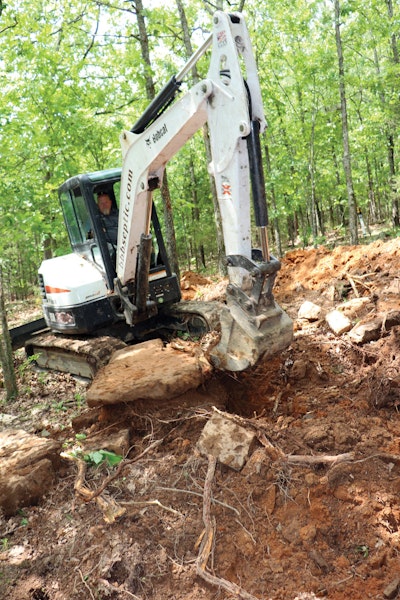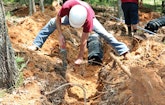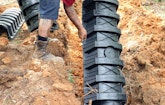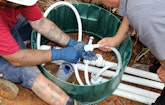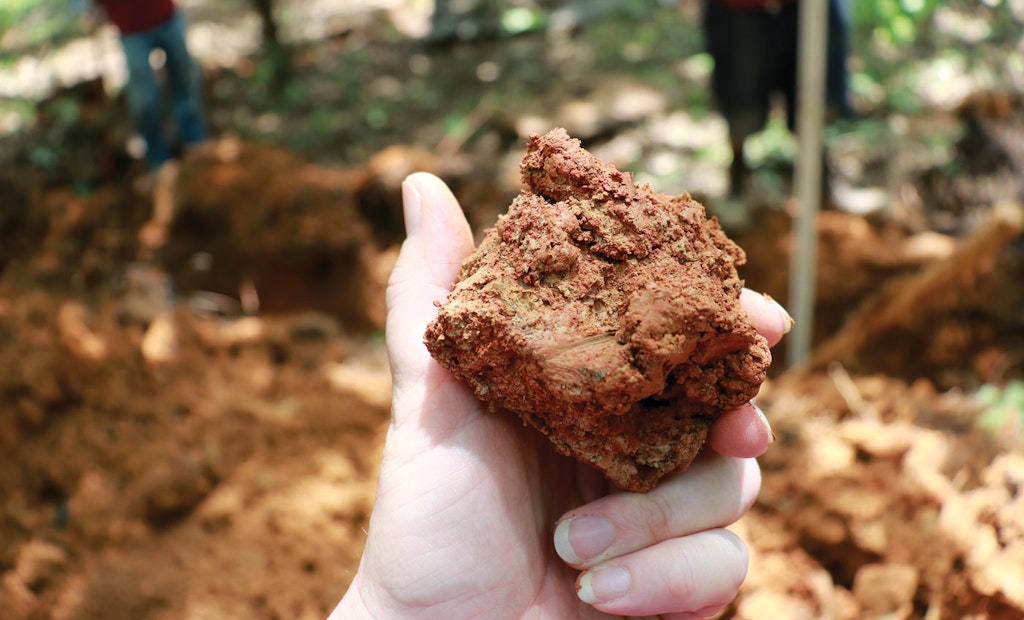
On the Fayetteville, Arkansas, project, the team from BBB Septic encountered Enders soil, a clay that comes from shale or a combination of shale and sandstone. (Photos courtesy of BBB Septic)
The owner of a rental house had a failing onsite system, and untreated wastewater was flowing downhill toward a creek. But when a crew from BBB Septic of Bentonville, Arkansas, replaced the old tank, it was clear a new tank would not solve the problem because the drainfield was also failing.
The house was probably built in the 1950s and had a septic tank with cement block walls and a concrete slab for a bottom, says Piper Satterfield, septic system design specialist with BBB. It’s another version of a cesspool, she says. “I don’t know about the rest of the country, but back in the ’50s, Arkansas didn’t really have any codes. So it’s not uncommon.”
Soil downhill from the house was unsuitable, so her solution to this problem involved pushing water uphill to a new system.
Plastic tanks
Wastewater leaves the house in a 4-inch Schedule 40 pipe, and it travels about 10 feet before it enters the septic tank. (That’s the minimum distance from any structure under Arkansas code.)
The tank is a 1,000-gallon poly tank from Norwesco that was installed before the failing drainfield was discovered. Technicians removed the walls of the original tank and set the new septic tank on the old slab, which was still level. A WW1 filter from Clarus Environmental is on the outlet, and the owner intends to clean it himself.
Water flows by gravity to a 300-gallon Norwesco spherical pump tank set next to the septic tank. Because the site was so tight, a standard concrete tank delivered by crane would not have worked, Satterfield says. The same reasoning applies to use of the poly tank for the septic treatment.
A Zoeller 151 pump moves water from the pump tank through a 1 1/2-inch Schedule 40 pipe for about 100 feet and 12 feet uphill to the drainfield. A Clarus Environmental spider valve splits the flow between laterals, two 100-foot lines and one 75-foot line. (In Arkansas a distribution box is prohibited for unequal length lines. The options are a diversion-valve system or a spider valve.) A Zoeller panel controls the pumping.
“And we had to do that last line of unequal length because we had a shed that we were getting a little bit too close to,” she says. In any case, she says, the spider valve provides better distribution.
The laterals are inside Quick4 Equalizer 24 chambers from Infiltrator Water Technologies installed 18 inches deep and 18 inches on center.
To do the job, the BBB crew used muscle, hand tools and a Bobcat E50 excavator.
Clay everywhere
The soil on the property is called Enders soil. It’s a clay formed from sandstone, and it is not good for absorption. There was clay near the surface, but in some places, soil was still good enough to take a conventional system, Satterfield says.
“Fortunately it was just a one-bedroom home. If it had been any bigger, we’d have a different situation,” she says.
The owner hoped to sell the home as a two-bedroom property, but there isn’t enough space for a drainfield of that size, she says.
There was no perc test for the site. What’s required in Arkansas is a soil morphology test, Satterfield says. Instead of watching water drain in a hole, designers must dig a 4-foot-deep pit and look at the soil in detail. The state learned long ago that any test hole anywhere will perc during the drought months of July and August, she says. In the rainy season, it’s a different story.
“I look for different features in the soil that will tell me how water will move and how water is there on seasonal basis,” she says. “These features we look for take years and decades to form, so it’s a better view of the long-term history of the soil versus what’s going on with the weather at that point.” The goal is to provide enough storage in the soil so heavy rains will not overwhelm a system.
When she started the project, Satterfield first looked downhill from the house for a drainfield site. “As soon as we dug the first pit, it was pretty obvious it wasn’t going to work,” she says. The soil was more than 50% clay, and other test holes looked the same.
“Aside from the high clay, water was shooting into the hole as we dug those first three pits,” she says. “So we started digging uphill, and we got better soil, still not good soil, but it was fairly suitable for a standard system.”
Water woes
The client’s house is located on a flat spot of a long downhill slope. Because of the state’s heavy seasonal rains, and because the large percentage of clay makes it more likely the drainfield could be overwhelmed, Satterfield says she talked to the owner about the possibility of adding a curtain drain if he has problems in the future. The drain would be a 24-inch-wide trench about 3 feet deep and lined with plastic on the downhill side to stop water from reaching the drainfield. Gravel would fill the trench, and a perforated pipe would redirect water to the ends of the trench and away from the drainfield.
A well on the property had to be abandoned because the only soil for the drainfield was within the state’s required 100-foot setback. Fortunately, she says, the house was already being served by municipal water.
During installation, technicians didn’t walk in the trenches, and they raked the bottoms and sides to make sure the clay was broken up and would allow water to pass through, she says. Weather was also a factor.
“We were hard-pressed to find a couple of days’ dry weather to even install this, because we were kind of in the Arkansas monsoon season,” Satterfield says.
But the biggest challenge for the installation crew were the big rocks scattered across the site. Brook Cannedy, the company’s senior installer, says they made for ugly trenches, too, because he could not get the sidewalls to be smooth and straight.
